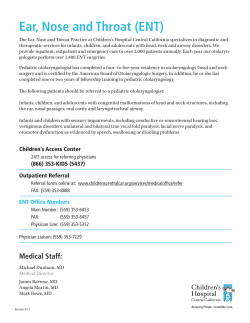
CS 1 - Commissioning Statement Septorhinoplasty
CS 1 - Commissioning Statement Septorhinoplasty Author: Start date: Review date: NHS Suffolk Public Health Team January 2012 January 2015 Commissioning Summary Septorhinoplasty is considered to be a low priority treatment and will only be funded by NHS Suffolk in line with the criteria below. Rhinoplasty/septorhinoplasty for purely cosmetic reasons will not be commissioned. Clinicians wishing to undertake septorhinoplasty will need to complete a prior approval form to be submitted to the PCT. This is not required when the procedure is undertaken as an emergency (non elective care) which can proceed, where there is clinical need, at the discretion of the clinician without prior approval. If septorhinoplasty is required for a condition not included in the criteria below then an application will need to be made to the Individual Funding Request Panel. Treatment criteria NHS Suffolk will fund septorhinoplasty for the following clinical indications: 1. Documented continuous nasal airway obstruction that results in nasal breathing associated with a septal/bony deviation of the nose. or 2. Post-traumatic nasal deformity associated with documented sustained interference of the airway; or 3. As part of the treatment for congenital abnormalities e.g. cleft lip and palate or 4. Surgery for the correction of iatrogenic causes for e.g. following previous nasal surgery and there is an identified, documented clinical need and not purely for cosmetic reasons. Background to the condition and treatment Septorhinoplasty is a surgical procedure to correct a deformity of the nasal septum as well as the bony deformity of the pyramid of the nose. It aims to improve both the functional, as well as the deformity of the external nose. The nasal obstruction can be as a result of the deviation of the cartilage of the nasal septum (internally) or from the bony deformity of the nasal bones (externally). If the cartilage of the nasal septum is the only problem then it can be corrected by a simple "Septoplasty" operation to improve breathing. However, if the bony pyramid of the nose is deviated and causing nasal obstruction as well as the septal cartilege, that will require a "Septorhinoplasty" operation. Asymptomatic septal deviation does not require treatment however surgical correction may be the only treatment for symptomatic nasal deviation. The primary indication for surgical treatment of a deviated nasal septum is nasal airway obstruction. It may also be performed following a nasal trauma or in conjunction with a cleft palate repair. There are several techniques that can be used to straighten and thin a displaced or deviated septum but the aim is to first lift the mucosal lining off the septum and subsequently to remove or reposition the obstructing pieces of cartilage. The potential complications of septorhinoplasty include septal perforation, failure to completely improve breathing due to swollen membranes as is seen in allergic patients, postoperative bleeding, nasal crusting and re-obstruction due to improper healing and scarring creating intranasal synechiae (adhesions). Definitions Nasal surgery is any procedure performed on the external or internal structures of the nose, septum or turbinate to improve abnormal function, reconstruct congenital or acquired deformities, or to enhance appearance. Septoplasty is the surgical procedure that corrects nasal septum defects or deformities, by alteration, splinting, or partial removal of obstructing supporting structures. Rhinoplasty is a surgical procedure to alter the structure of the nose. Bone or cartilage may be removed, tissue grafted from another part of the body, or synthetic material implanted to alter the shape of the nose. Septorhinoplasty is a procedure combining rhinoplasty with major repair of the nasal septum. Deviated septum is a bent or irregular projection or deflection (e.g., bony spur) of the nasal septum into the nasal airway. This can be a developmental anomaly or it can result from trauma. The deformity can be anterior (cartilaginous), posterior (bony) or both. References 1. Modernisation Agency Document ‘Information for Commissioners of Plastic Surgery Services; Referrals and Guidelines in Plastic Surgery’. Prepared by the British Association of Plastic and Reconstructive Surgery. 2. NHS Hull. General Commissioning Policy Statement. Rhinoplasty / Septoplasty / Septo-rhinoplasty. March 2011. 3. NHS Leicestershire 4. NHS Bristol. Policy Statement. Rhinoplasty. March 2009. 5. NHS North West London. Policy statement. Rhinoplasty. August 2011. 6. Aetna Clinical Policy Bulletin: Septoplasty and Rhinoplasty. March 2011. http://www.aetna.com/cpb/medical/data/1_99/0005.html Appendix ICD10 Codes J342 L905 M950 T857 Z420 Z462 J348 J342 J348 M950 J342 J348 M950 Q302 Q359 Q379 Z411 Z420 J342 J348 M950 Q758 S022 Z420 J342 OPCS Codes E028 E028 E028 E028 E028 E028 E025 E073 E073 E073 E026 E026 E026 E026 E026 E026 E026 E026 E024 E024 E024 E024 E024 E024 E023
© Copyright 2025





















